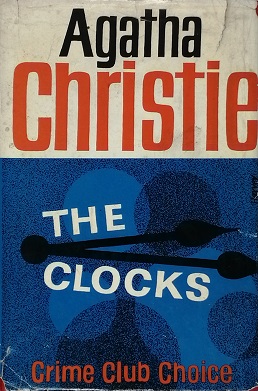
I’ve reached the point where I can’t really remember which Agatha Christie novels I’ve read and which I haven’t. Which I suppose is a good thing, because it means I can go back and re-read them and will have probably forgotten who the murderer is. Or, more likely, think I’m being very clever when it comes back to me.
But I definitely hadn’t read The Clocks before. Published in 1963, that means it falls towards the end of her writing career – but before the books got really bad. It’s also technically a Hercule Poirot but, for reasons we will come onto, it doesn’t really feel like one.
(Btw, I shan’t give away huge spoilers – like the culprit – but there will be some milder spoilers in this review, so you are warned.)
The location of the murder is 19, Wilbraham Crescent. Christie describes the street in a way that I enjoyed:
Wilbraham Crescent was a fantasy executed by a Victorian builder in the 1880’s [sic]. It was a half-moon of double houses and gardens set back to back. This conceit was a source of considerable difficulty to persons unacquainted with the locality. Those who arrived on the outer side were unable to find the lower numbers and those who hit the inner side first were baffled as to the whereabouts of the higher numbers. The houses were neat, prim, artistically balconied and eminently respectable. Modernisation had as yet barely touched them – on the outside, that is to say. Kitchens and bathrooms were the first to feel the wind of change.
I think that’s a lovely observational, about kitchens and bathrooms, and it’s expressed well and elegantly. Christie is often unfairly dismissed an excellent plotter and poor writer, but I disagree. A lot of The Clocks is quietly amusing and she has a good eye for social detail.
Anyway, a young typist called Sheila Webb is called to a new client’s house. Mrs Pebmarsh has requested her by name to 19, Wilbraham Crescent, and off she goes, letting herself in (as instructed). She finds a living room with numerous clocks on the mantlepiece and other places – far more clocks than anybody would normally need. And, more curiously, they are all at 4:13pm – an hour ahead of the current time.
But that’s the strangest thing Sheila finds in the room. The other, behind the sofa, is the body of a dead man.
She runs out screaming, and encounters our narrator for half the novel – Colin Lamb. Christie goes back and forth between third-person narrator and Colin’s perspective, and he is really our detective for the novel. He’s also rather smitten by Sheila.
We gather some facts: Mrs Pebmarsh says she did not request a typist. She does not know who the man in her house is, and she is blind – so he may have been there for a while without her noticing. Colin begins questioning all the various neighbours, who do rather get confusing, as we pretty quickly go to lots of different houses and encounter a large number of people who may or may not have any bearing on the novel. It’s an opportunity for Christie to enjoy herself though – there’s a ‘cat lady’ totally devoted to her cats; there are some rowdy but intelligent young boys; there is a glimpse of a certain type of political discourse in 1963:
“Each of these four clocks represented a time about an hour later than the cuckoo clock and the grandfather clock.”
“Must have been foreign,” said Mrs Curtin. “Me and my old man went on a coach trip to Switzerland and Italy once and it was a whole hour further on there. Must be something to do with the Common Market. I don’t hold with the Common Market and nor does Mr Curtin. England’s good enough for me.”
Plus ça change, if I may.
So, where does Hercule Poirot come into this? Just barely. We know that we are in a Poirot novel because of there are stray mentions of Ariadne Oliver (and Christie has her usual good time poking fun at Oliver for choosing a Finnish detective when she doesn’t know anything about Finland). The man himself enters by way of interview with Colin Lamb, an old friend – or, rather, a younger friend whom Poirot tries to educate, but in a sort of frustrating way where he never says what he means. A few times, Colin Lamb traipses off to Poirot’s residence to lay his new findings at Poirot’s feet and get some sort of enigmatic reply in return. At no point does Poirot himself talk to anybody else involved, or visit the scene of the crime. It’s all rather strange. Why is he there at all?
For much of The Clocks, I thought I was onto a real winner, and wondered why it wasn’t talked about more about Christie’s oeuvre. It was a page-turner with entertaining writing and a fun (if occasionally slightly overwhelming) cast of characters. The sidelining of Poirot was odd, but I went with it. Even the occasional hints of spy rings didn’t put me off – and I find Christie very tedious in spy mode, which she couldn’t resist returning to.
Well – without spoilers – The Clocks did end up being a disappointment to me. I’ll just say that the solution wasn’t at all satisfying, and it felt very anti-climactic compared to her usual cleverness. I feel like the inventive set-up deserved a better pay-off. I’m glad I read it and I enjoyed myself, and from another author I’d be very impressed, but this definitely isn’t one of Christie’s masterpieces.


 The Elephants in My Backyard by Rajiv Surendra
The Elephants in My Backyard by Rajiv Surendra The Wall by Marlen Haushofer
The Wall by Marlen Haushofer

